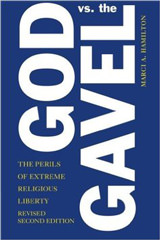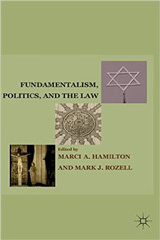Donald Trump has rightly been vilified for his ridiculous, laughable, obscene suggestion that Muslims be denied entry into the United States based on being . . . Muslim: whether you want to say it is “unpatriotic” or “ahistorical,” Trump is just wrong. He is betraying what makes America truly great: the absolute right to believe anything; the right to publicly criticize any viewpoint; and the obligation not to harm others through conduct. This is the three-part foundation of the First Amendment.
Just like Christianity and Judaism and Hinduism, among many other religions, the generic term for Islam covers so many subsets, it lacks content. Proposing to ban all Muslims in an attempt to keep terrorists out is like saying that we should bar all Christians to prevent violent white supremacists from entering the country. Wake up, Republicans, to the reality that every faith has extremists who will kill for their faith.
It’s not that Trump is wrong to use “Muslim”—rather, his mistake is in using it by itself. It is overbroad. One of the Muslim subsects is composed of extremist Islamic terrorists, which is what we should call it, as I pointed out here, and whom we need to exclude.
His major Democratic rival, Hillary Clinton, and President Obama until just recently, eschewed the “Muslim” or “Islamic” label altogether. Our enemy according to them is “terrorists.” That is also a big mistake, because it whitewashes with secular terminology the rabid, fanatical devotion our enemy embraces. This is no ordinary political or power-seeking enemy. This is an enemy where the end of serving God always justifies brutal, inhumane, and animal-like means. Wake up, Democrats, to the Inquisition of our lifetimes.
Trump favors himself as the man who speaks truth to politically correct (“PC”) speech. If the Democrats won’t use “Muslim” to describe the enemy, he will show them what’s wrong with being PC and race to the other extreme, and point to all Muslims. His use of “Muslim” is no more the truth than the Democrats’ silence on the term. With both political parties failing to exhibit civil and accurate discourse, our polarization seems destined to be permanent. But that is not necessarily so.
The time has come for civil, accurate discourse.
We need specific solutions to our difficult problems, not blunderbuss and showmanship. We need facts to drive public policy, not political correctness nor an irrational reaction to it. And we desperately need leaders to talk to each other, and not just those with whom they agree. Why? Because no good solutions arise simply by staring at yourself in the mirror.
What happened to civil—even if passionate on both sides—discourse? Let’s imagine a different scenario in the war on terror. First, drop the dysfunctional, religious taboos that require falsity—just call the religious enemy what it is. And don’t paint other believers with a false negative by an overbroad label. These religious taboos are what I sought to overcome with God vs. the Gavel, because if you cannot say anything negative about religion, you, in effect, have chosen to whitewash too much harmful and even criminal behavior. Only the truth will protect the victims that already exist and prevent more in the future.
Second, have a debate with the other side that involves speaking cordially and then listening. No need to outshout the other but there is a desperate need that you listen to the other. Then you might hear what the other side is saying. And you might learn something from the other side, because we all have a lot to learn.
More importantly, respect the right of every American to make her own political and religious decisions and to say what she wants. You can condemn her actions while you are talking, but it is simply wrong to silence her. The belief-speech-conduct triptych of the First Amendment is critically important here.
Penn Shows that Civil Discourse Is Possible
The proof that civil discourse is possible lies in the Program in Research on Religion and Urban Civil Society at the University of Pennsylvania, which is engaging in a social experiment like no other in the Common Ground for Common Good Project. This is the brainchild of the visionary Penn political science Professor John DiIulio, who was the first to launch the White House Office of Faith-based and Community Initiatives. Stanley Carlson Thies, Director of the Institutional Religious Freedom Alliance, and I are co-chairs. The point is to see whether a group of people from both (actually several) sides of the political/religious divide can have a conversation and agree on anything for the common good. The answer is that the talk itself is riveting, important, and a discussion of differences can be had among civilized adults. To quote Professor DiIulio, “Who knew?!” Of course, he did.
And guess what—there is common ground to be found. While there is disagreement on adoption agencies having to serve all couples, even those that are same-sex, there is adamant agreement that even conservative religious organizations should and will feed hungry children and partners from same-sex marriages. There is also agreement that the welfare and protection of children must be central to a good society. Even more importantly, those of us who might never have spoken to each other have learned that the “enemy” is actually “good people.” And this is only after two meetings.
Presidential candidates need to model civil, accurate discourse. It helps no one if either Party refuses to name the “X” right in front of them. This is especially so because the natural political response to such censorship is to say “X” times ten. And that is what the Democrats, and now Trump in reaction, have done.
Let the civil and accurate discussion begin.
The photo above was taken at a meeting for the Common Ground for Common Good Project.
First row left to right: Joseph P. Tierney, University of Pennsylvania; Dr. Stanley Carlson-Thies, Institutional Religious Freedom Alliance; Prof. Marci Hamilton, Yeshiva University; Prof. John J. DiIulio, Jr., University of Pennsylvania
Back row left to right: Dr. Lia Howard, St. Joseph’s University; Rev. Dr. Charles Howard, University of Pennsylvania; Sister Mary Scullion, Project HOME; Michael Wear, Public Square Strategies, LLC; Rev. Dr. W. Wilson Goode, Sr., Amachi, Inc.; Prof. Richard Valelly, Swarthmore College; Jane Eisner, The Forward; Rev. Luis Cortés, Jr., Esperanza; The Hon. Kathleen Kennedy-Townsend, The Rock Creek Group; Tim Goeglein, Focus on the Family; Rev. Dr. Ronald J. Sider, Eastern University
Not pictured: Dr. E.J. Dionne, Brookings Institution









